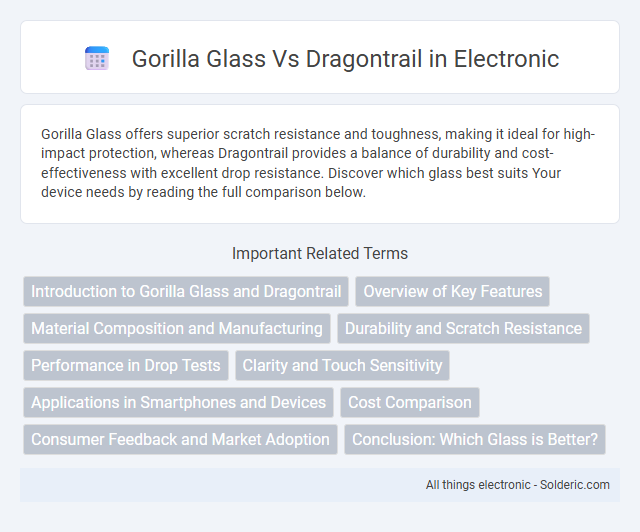Gorilla Glass offers superior scratch resistance and toughness, making it ideal for high-impact protection, whereas Dragontrail provides a balance of durability and cost-effectiveness with excellent drop resistance. Discover which glass best suits Your device needs by reading the full comparison below.
Comparison Table
| Feature | Gorilla Glass | Dragontrail Glass |
|---|---|---|
| Manufacturer | Corning Inc. | AGC Inc. (Asahi Glass) |
| Material Type | Aluminosilicate Glass | Aluminosilicate Glass |
| Hardness | Mohs 6-7 | Mohs 6-7 |
| Scratch Resistance | High | Moderate to High |
| Impact Resistance | Excellent | Good |
| Thickness Range | 0.4 - 1.0 mm | 0.4 - 1.1 mm |
| Typical Uses | Smartphones, tablets, wearables | Smartphones, rugged devices |
| Cost | Higher | Lower |
| Market Presence | Global, dominant in flagship devices | Popular in mid-range and rugged markets |
| Latest Version | Gorilla Glass Victus 2 (2022) | Dragontrail X (latest version) |
Introduction to Gorilla Glass and Dragontrail
Gorilla Glass, developed by Corning, is a chemically strengthened glass widely used in smartphones and electronic devices for its scratch resistance and durability. Dragontrail glass, created by Asahi Glass Co., offers similar protective qualities with a strong emphasis on impact resistance and thinness, primarily used in Asian-manufactured gadgets. Both glasses utilize ion-exchange processes to enhance surface strength, making them leading choices in touchscreen protection technology.
Overview of Key Features
Gorilla Glass offers superior toughness and scratch resistance due to its chemically strengthened aluminosilicate composition, making it highly durable for smartphones and tablets. Dragontrail glass features excellent impact resistance and flexibility, providing strong protection against drops and bends while maintaining clarity. Both types deliver robust protection with Gorilla Glass excelling in scratch hardness and Dragontrail prioritizing shatter resistance and cost-effectiveness.
Material Composition and Manufacturing
Gorilla Glass is primarily made from an alkali-aluminosilicate sheet glass that undergoes a chemical strengthening process involving ion exchange, enhancing its scratch resistance and durability. Dragontrail glass also uses alkali-aluminosilicate composition but features a different ion exchange treatment designed by Asahi Glass Co., providing high toughness and impact resistance. Both materials utilize advanced manufacturing techniques to optimize strength while maintaining thinness, making them ideal for smartphones and other electronic displays.
Durability and Scratch Resistance
Gorilla Glass, developed by Corning, is engineered with an aluminosilicate composition that enhances its durability and scratch resistance, achieving high performance in impact and abrasion tests. Dragontrail, produced by Asahi Glass, utilizes a chemically strengthened alkali-aluminosilicate glass, providing competitive scratch resistance and resistance against cracks but generally ranks slightly lower than Gorilla Glass in drop durability. Both glasses are widely used in smartphones and tablets, with Gorilla Glass favored for heavy-impact protection and Dragontrail preferred in budget-friendly devices due to its cost-effective durability.
Performance in Drop Tests
Gorilla Glass consistently outperforms Dragontrail in drop tests, showcasing superior resistance to impact and cracking due to its chemically strengthened aluminosilicate composition. Your device is more likely to survive accidental drops intact with Gorilla Glass, which features higher scratch resistance and enhanced durability under repeated stress. Dragontrail, while robust, generally offers less protection against shattering compared to Gorilla Glass's advanced ion-exchange technology.
Clarity and Touch Sensitivity
Gorilla Glass offers superior clarity with high light transmittance, enhancing display brightness and color accuracy for vivid visuals. Its advanced ion-exchange process provides exceptionally smooth touch sensitivity, ensuring precise and responsive screen interactions. Dragontrail glass delivers good clarity but often exhibits slightly lower light transmittance, and touch responsiveness can feel less fluid compared to Gorilla Glass.
Applications in Smartphones and Devices
Gorilla Glass is widely used in high-end smartphones and tablets due to its superior scratch resistance and durability, making it ideal for premium devices from brands like Samsung, Apple, and Google. Dragontrail glass, developed by Asahi Glass Co., is commonly found in mid-range and rugged smartphones, balancing cost-effectiveness with solid protection against impacts and scratches. Both glasses are engineered for touchscreen devices, but Gorilla Glass typically offers higher performance in durability testing, influencing its adoption in flagship smartphones and wearables.
Cost Comparison
Gorilla Glass typically commands a higher price point due to its brand recognition, extensive testing, and widespread use in flagship devices, while Dragontrail offers a more cost-effective alternative favored by budget smartphone manufacturers. The lower production and licensing costs of Dragontrail contribute to its affordability without significantly compromising durability. Manufacturers often select Gorilla Glass for premium products aiming to justify the price premium, whereas Dragontrail suits mid-range devices balancing cost and performance.
Consumer Feedback and Market Adoption
Gorilla Glass consistently receives higher consumer satisfaction due to its superior scratch resistance and widespread use in flagship smartphones, reinforcing its strong market adoption by major brands like Apple and Samsung. Dragontrail, favored for affordability and adequate durability, sees adoption primarily in mid-range devices, appealing to budget-conscious consumers while earning mixed feedback on scratch resilience. Your choice may hinge on device pricing and priority for premium protection, with Gorilla Glass leading in both consumer trust and global market penetration.
Conclusion: Which Glass is Better?
Gorilla Glass offers superior scratch resistance and better drop protection due to its chemically strengthened aluminosilicate composition, making it a preferred choice for flagship smartphones. Dragontrail provides comparable durability with enhanced flexibility and impact resistance, often featured in mid-range devices seeking a balance between cost and performance. Overall, Gorilla Glass is generally considered better for premium protection, while Dragontrail suits budget-conscious users requiring reliable toughness.
Gorilla Glass vs Dragontrail Infographic

 solderic.com
solderic.com